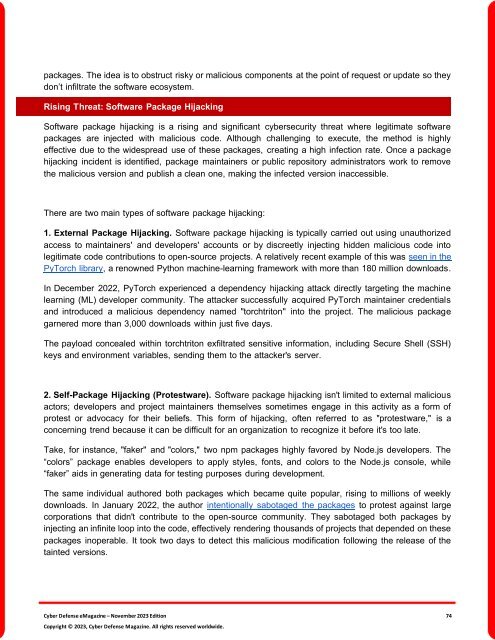The Cyber Defense eMagazine November Edition for 2023
Cyber Defense eMagazine November Edition for 2023 #CDM #CYBERDEFENSEMAG @CyberDefenseMag by @Miliefsky a world-renowned cyber security expert and the Publisher of Cyber Defense Magazine as part of the Cyber Defense Media Group as well as Yan Ross, Editor-in-Chief and many more writers, partners and supporters who make this an awesome publication! 196 page November Edition fully packed with some of our best content. Thank you all and to our readers! OSINT ROCKS! #CDM #CDMG #OSINT #CYBERSECURITY #INFOSEC #BEST #PRACTICES #TIPS #TECHNIQUES
Cyber Defense eMagazine November Edition for 2023 #CDM #CYBERDEFENSEMAG @CyberDefenseMag by @Miliefsky a world-renowned cyber security expert and the Publisher of Cyber Defense Magazine as part of the Cyber Defense Media Group as well as Yan Ross, Editor-in-Chief and many more writers, partners and supporters who make this an awesome publication! 196 page November Edition fully packed with some of our best content. Thank you all and to our readers! OSINT ROCKS! #CDM #CDMG #OSINT #CYBERSECURITY #INFOSEC #BEST #PRACTICES #TIPS #TECHNIQUES
You also want an ePaper? Increase the reach of your titles
YUMPU automatically turns print PDFs into web optimized ePapers that Google loves.
packages. <strong>The</strong> idea is to obstruct risky or malicious components at the point of request or update so they<br />
don’t infiltrate the software ecosystem.<br />
Rising Threat: Software Package Hijacking<br />
Software package hijacking is a rising and significant cybersecurity threat where legitimate software<br />
packages are injected with malicious code. Although challenging to execute, the method is highly<br />
effective due to the widespread use of these packages, creating a high infection rate. Once a package<br />
hijacking incident is identified, package maintainers or public repository administrators work to remove<br />
the malicious version and publish a clean one, making the infected version inaccessible.<br />
<strong>The</strong>re are two main types of software package hijacking:<br />
1. External Package Hijacking. Software package hijacking is typically carried out using unauthorized<br />
access to maintainers' and developers' accounts or by discreetly injecting hidden malicious code into<br />
legitimate code contributions to open-source projects. A relatively recent example of this was seen in the<br />
PyTorch library, a renowned Python machine-learning framework with more than 180 million downloads.<br />
In December 2022, PyTorch experienced a dependency hijacking attack directly targeting the machine<br />
learning (ML) developer community. <strong>The</strong> attacker successfully acquired PyTorch maintainer credentials<br />
and introduced a malicious dependency named "torchtriton" into the project. <strong>The</strong> malicious package<br />
garnered more than 3,000 downloads within just five days.<br />
<strong>The</strong> payload concealed within torchtriton exfiltrated sensitive in<strong>for</strong>mation, including Secure Shell (SSH)<br />
keys and environment variables, sending them to the attacker's server.<br />
2. Self-Package Hijacking (Protestware). Software package hijacking isn't limited to external malicious<br />
actors; developers and project maintainers themselves sometimes engage in this activity as a <strong>for</strong>m of<br />
protest or advocacy <strong>for</strong> their beliefs. This <strong>for</strong>m of hijacking, often referred to as "protestware," is a<br />
concerning trend because it can be difficult <strong>for</strong> an organization to recognize it be<strong>for</strong>e it's too late.<br />
Take, <strong>for</strong> instance, "faker" and "colors," two npm packages highly favored by Node.js developers. <strong>The</strong><br />
“colors” package enables developers to apply styles, fonts, and colors to the Node.js console, while<br />
“faker” aids in generating data <strong>for</strong> testing purposes during development.<br />
<strong>The</strong> same individual authored both packages which became quite popular, rising to millions of weekly<br />
downloads. In January 2022, the author intentionally sabotaged the packages to protest against large<br />
corporations that didn't contribute to the open-source community. <strong>The</strong>y sabotaged both packages by<br />
injecting an infinite loop into the code, effectively rendering thousands of projects that depended on these<br />
packages inoperable. It took two days to detect this malicious modification following the release of the<br />
tainted versions.<br />
<strong>Cyber</strong> <strong>Defense</strong> <strong>eMagazine</strong> – <strong>November</strong> <strong>2023</strong> <strong>Edition</strong> 74<br />
Copyright © <strong>2023</strong>, <strong>Cyber</strong> <strong>Defense</strong> Magazine. All rights reserved worldwide.

















